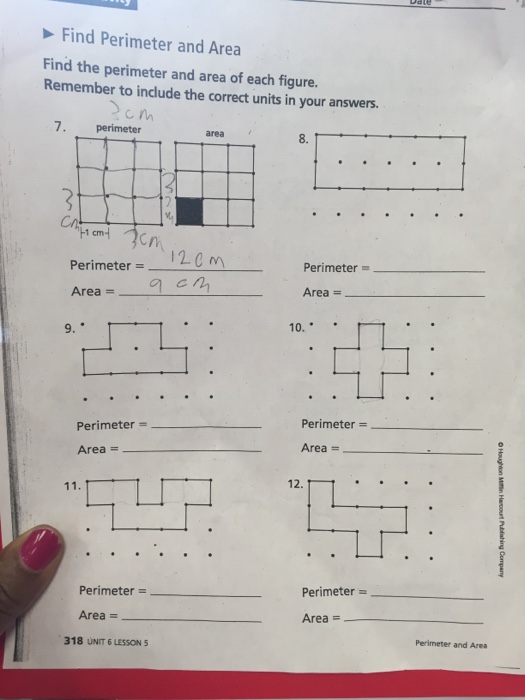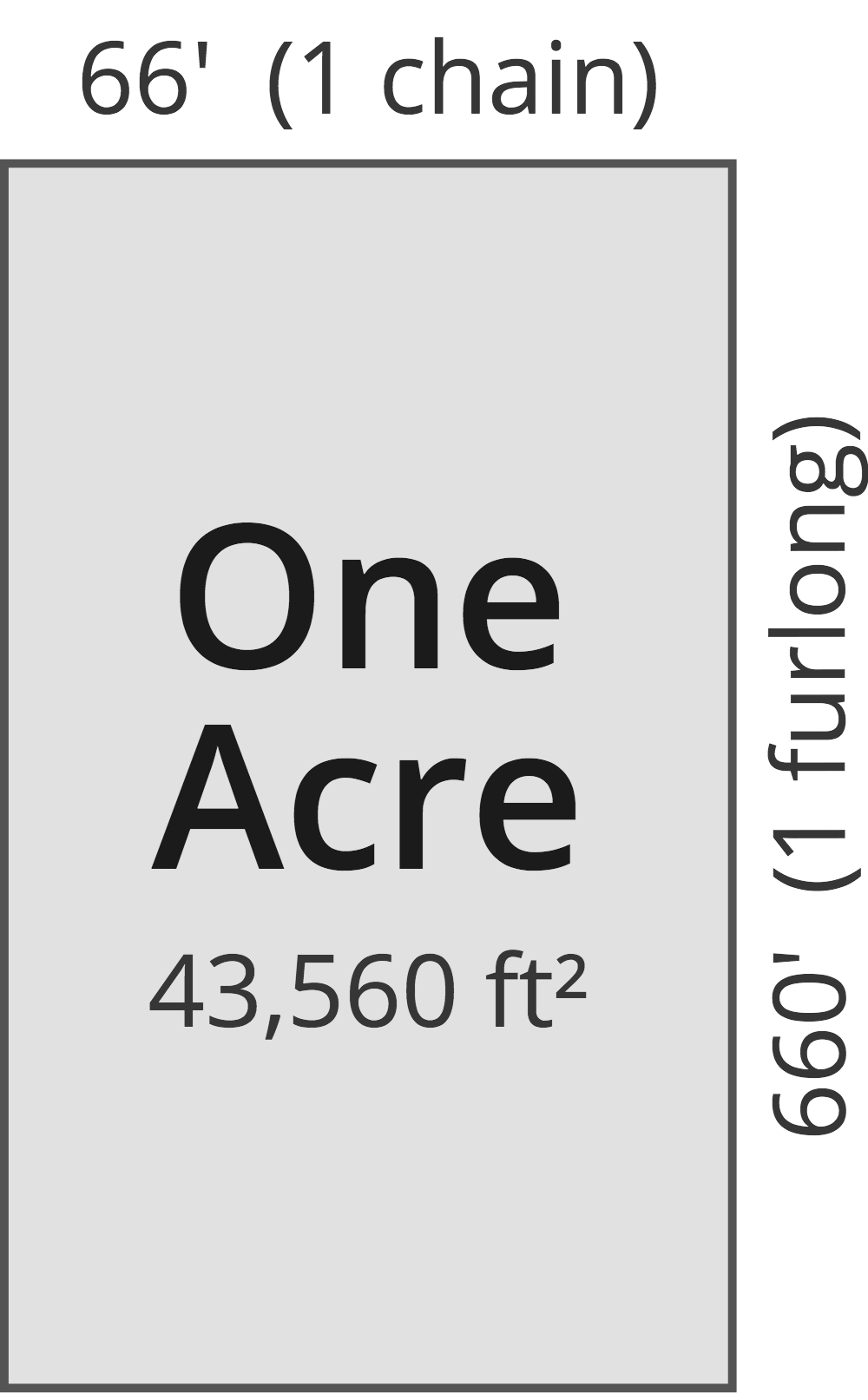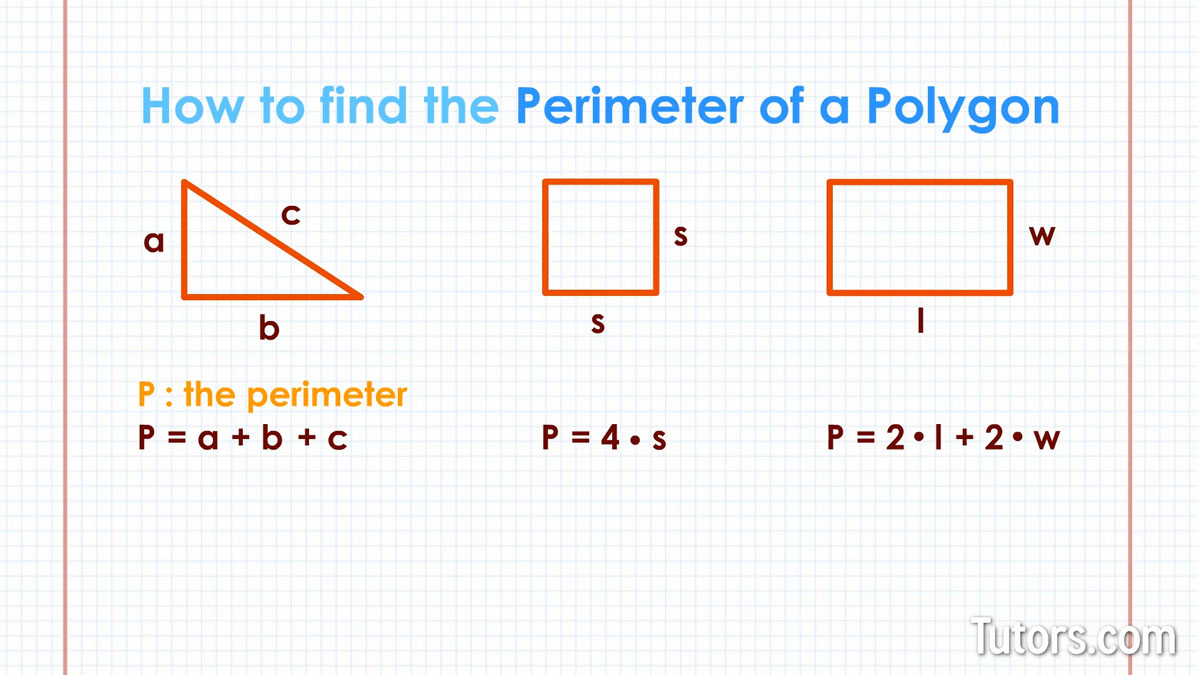Topic find the perimeter and area of each figure: Understanding how to find the perimeter and area of various geometric figures is essential in both academics and real-life applications. This article provides a clear and concise guide to the formulas and methods needed to calculate these measurements for different shapes, ensuring you have the knowledge to tackle any geometry problem with confidence.
Table of Content
- Finding the Perimeter and Area of Each Figure
- Introduction
- Basic Geometry Concepts
- Perimeter and Area Formulas
- Composite Figures
- Real-life Applications
- Practice Problems
- Conclusion
- YOUTUBE: Học cách tìm chu vi và diện tích của một hình hợp nhất với ví dụ về hình chữ L trong video này. Phù hợp cho những ai đang tìm hiểu về chu vi và diện tích các hình khác nhau.
Finding the Perimeter and Area of Each Figure
To find the perimeter and area of various geometric figures, follow these formulas and steps for each shape:
Rectangle
- Perimeter: \( P = 2(l + w) \)
- Area: \( A = lw \)
Square
- Perimeter: \( P = 4s \)
- Area: \( A = s^2 \)
Triangle
- Perimeter: \( P = a + b + c \)
- Area: \( A = \frac{1}{2}bh \)
Circle
- Circumference (Perimeter): \( C = 2\pi r \)
- Area: \( A = \pi r^2 \)
Parallelogram
- Perimeter: \( P = 2(a + b) \)
- Area: \( A = bh \)
Trapezoid
- Perimeter: \( P = a + b + c + d \)
- Area: \( A = \frac{1}{2}(a + b)h \)
Ellipse
- Circumference (Approximate): \( C \approx 2\pi \sqrt{\frac{a^2 + b^2}{2}} \)
- Area: \( A = \pi ab \)
Regular Polygon
For a regular polygon with \( n \) sides and side length \( s \):
- Perimeter: \( P = ns \)
- Area: \( A = \frac{1}{4}ns^2 \cot \left(\frac{\pi}{n}\right) \)
Examples
| Shape | Perimeter Formula | Area Formula |
|---|---|---|
| Rectangle | \( P = 2(l + w) \) | \( A = lw \) |
| Square | \( P = 4s \) | \( A = s^2 \) |
| Triangle | \( P = a + b + c \) | \( A = \frac{1}{2}bh \) |
| Circle | \( C = 2\pi r \) | \( A = \pi r^2 \) |
| Parallelogram | \( P = 2(a + b) \) | \( A = bh \) |
| Trapezoid | \( P = a + b + c + d \) | \( A = \frac{1}{2}(a + b)h \) |
| Ellipse | \( C \approx 2\pi \sqrt{\frac{a^2 + b^2}{2}} \) | \( A = \pi ab \) |
| Regular Polygon | \( P = ns \) | \( A = \frac{1}{4}ns^2 \cot \left(\frac{\pi}{n}\right) \) |

READ MORE:
Introduction
Understanding how to calculate the perimeter and area of various geometric figures is essential in geometry and applicable in many real-life situations. This guide provides detailed explanations and formulas for calculating the perimeter and area of common shapes such as rectangles, squares, triangles, circles, and more. By mastering these concepts, you will be equipped to solve a wide range of practical problems efficiently.
Basic Geometry Concepts
Understanding the basic geometry concepts is essential for finding the perimeter and area of various figures. Here, we will explore the definitions and properties of key geometric shapes and their measurements.
Definitions
- Point: A location in space without any dimensions.
- Line: A one-dimensional figure extending infinitely in both directions.
- Plane: A two-dimensional surface extending infinitely.
- Angle: Formed by two rays with a common endpoint, measured in degrees or radians.
Basic Shapes and Properties
Here are some fundamental geometric shapes and their key properties:
| Shape | Definition | Properties |
|---|---|---|
| Rectangle | A quadrilateral with opposite sides equal and all angles 90 degrees. | Area: \( A = l \times w \) Perimeter: \( P = 2(l + w) \) |
| Square | A quadrilateral with all sides equal and all angles 90 degrees. | Area: \( A = s^2 \) Perimeter: \( P = 4s \) |
| Triangle | A polygon with three sides and three angles. | Area: \( A = \frac{1}{2} \times b \times h \) Perimeter: \( P = a + b + c \) |
| Circle | A set of points equidistant from a center point. | Area: \( A = \pi r^2 \) Circumference: \( C = 2\pi r \) |
| Parallelogram | A quadrilateral with opposite sides parallel and equal. | Area: \( A = b \times h \) Perimeter: \( P = 2(a + b) \) |
| Trapezoid | A quadrilateral with at least one pair of parallel sides. | Area: \( A = \frac{1}{2} \times (a + b) \times h \) Perimeter: \( P = a + b + c + d \) |
| Ellipse | An oval shape, defined by two axes. | Area: \( A = \pi \times a \times b \) Perimeter: Approximation |
Perimeter and Area Formulas
Understanding the perimeter and area of various geometric figures is essential in both academic studies and real-world applications. This section provides detailed formulas to calculate the perimeter and area of common geometric shapes.
Rectangle
- Perimeter: \( P = 2(l + w) \), where \( l \) is the length and \( w \) is the width.
- Area: \( A = lw \).
Square
- Perimeter: \( P = 4a \), where \( a \) is the side length.
- Area: \( A = a^2 \).
Triangle
- Perimeter: \( P = a + b + c \), where \( a \), \( b \), and \( c \) are the side lengths.
- Area: \( A = \frac{1}{2}bh \), where \( b \) is the base and \( h \) is the height.
Circle
- Perimeter (Circumference): \( C = 2\pi r \), where \( r \) is the radius.
- Area: \( A = \pi r^2 \).
Parallelogram
- Perimeter: \( P = 2(a + b) \), where \( a \) and \( b \) are the lengths of the sides.
- Area: \( A = bh \), where \( b \) is the base and \( h \) is the height.
Trapezoid
- Perimeter: \( P = a + b + c + d \), where \( a \), \( b \), \( c \), and \( d \) are the lengths of the sides.
- Area: \( A = \frac{1}{2}(a + b)h \), where \( a \) and \( b \) are the lengths of the parallel sides and \( h \) is the height.
Ellipse
- Perimeter: Approximation using \( P \approx \pi [3(a + b) - \sqrt{(3a + b)(a + 3b)}] \), where \( a \) and \( b \) are the semi-major and semi-minor axes respectively.
- Area: \( A = \pi ab \).
Regular Polygon
- Perimeter: \( P = ns \), where \( n \) is the number of sides and \( s \) is the side length.
- Area: \( A = \frac{1}{4}ns^2 \cot(\frac{\pi}{n}) \).
Composite Figures
For composite figures, calculate the perimeter and area by breaking the figure down into simpler shapes, finding the perimeter and area of each, and then summing them up.
Composite Figures
Composite figures, also known as compound shapes, are shapes that are made up of two or more simple geometric figures such as rectangles, squares, triangles, circles, and semicircles. To find the perimeter and area of a composite figure, we break it down into its basic shapes, find the perimeter and area of each shape, and then combine the results.
Steps to Find the Area of Composite Figures
- Identify the simple shapes that make up the composite figure.
- Calculate the area of each simple shape using the appropriate formulas.
- Add the areas of all the simple shapes to get the total area of the composite figure.
Example 1: Rectangle and Semicircle
Consider a composite figure consisting of a rectangle and a semicircle.
- The length of the rectangle is \( l \) and the width is \( w \).
- The diameter of the semicircle is equal to the width of the rectangle, \( d = w \).
The area of the rectangle \( A_{\text{rectangle}} \) is:
\[ A_{\text{rectangle}} = l \times w \]
The area of the semicircle \( A_{\text{semicircle}} \) is:
\[ A_{\text{semicircle}} = \frac{1}{2} \pi \left( \frac{d}{2} \right)^2 = \frac{1}{2} \pi \left( \frac{w}{2} \right)^2 = \frac{1}{8} \pi w^2 \]
The total area \( A_{\text{total}} \) of the composite figure is:
\[ A_{\text{total}} = A_{\text{rectangle}} + A_{\text{semicircle}} = l \times w + \frac{1}{8} \pi w^2 \]
Example 2: Square and Triangle
Consider a composite figure consisting of a square and a triangle.
- The side length of the square is \( s \).
- The base of the triangle is \( b \) and the height is \( h \).
The area of the square \( A_{\text{square}} \) is:
\[ A_{\text{square}} = s^2 \]
The area of the triangle \( A_{\text{triangle}} \) is:
\[ A_{\text{triangle}} = \frac{1}{2} b \times h \]
The total area \( A_{\text{total}} \) of the composite figure is:
\[ A_{\text{total}} = A_{\text{square}} + A_{\text{triangle}} = s^2 + \frac{1}{2} b \times h \]
Finding the Perimeter of Composite Figures
- Identify the outer boundary of the composite figure.
- Calculate the perimeter of each part of the boundary.
- Add the perimeters of all the parts to get the total perimeter.
Example 3: L-shaped Figure
Consider an L-shaped figure made up of two rectangles.
- The dimensions of the vertical rectangle are \( l_1 \) and \( w_1 \).
- The dimensions of the horizontal rectangle are \( l_2 \) and \( w_2 \).
To find the perimeter, sum the lengths of all the outer edges:
\[ P = l_1 + w_1 + l_2 + w_2 + l_1 + w_2 - \text{overlap} \]
Note that the overlap is the part where the two rectangles share a side.
Composite figures often appear in real-life applications, such as architectural designs, engineering projects, and everyday objects. Practicing with various composite figures helps in understanding and solving more complex geometric problems.

Real-life Applications
The concepts of perimeter and area are essential in various real-life applications. These measurements help in fields such as construction, agriculture, interior design, and many more. Below are some practical examples and detailed explanations of how perimeter and area are used in everyday scenarios:
- Construction: When building structures, knowing the perimeter is crucial for determining the length of materials needed for framing, fencing, or building walls. The area is important for calculating the space available for construction and for planning the layout of different rooms.
- Gardening: In gardening, the perimeter helps in determining the length of the fencing required to enclose a garden. The area is used to calculate the amount of soil or mulch needed to cover the garden bed.
- Interior Design: Interior designers use area calculations to determine the amount of flooring, wallpaper, or paint required for a room. The perimeter can help in figuring out the lengths of baseboards or crown molding needed.
- Agriculture: Farmers use the area to determine the size of their fields and to calculate the amount of seeds, fertilizers, or pesticides required. The perimeter can be used to plan the length of irrigation pipes or fencing around the fields.
- Sports: In sports, the area of a playing field determines the space available for the game, while the perimeter helps in setting up boundaries or tracks.
- Urban Planning: Urban planners use the concepts of perimeter and area to design city layouts, parks, and public spaces. These measurements are essential for ensuring that spaces are used efficiently and meet the needs of the community.
- Art and Craft: Artists and crafters often need to calculate the area to determine the size of their canvas or the amount of material needed for a project. The perimeter can help in framing the artwork or setting up displays.
Below are some formulas used in calculating the perimeter and area of common shapes:
| Shape | Perimeter Formula | Area Formula |
|---|---|---|
| Rectangle | \(P = 2(l + w)\) | \(A = l \times w\) |
| Square | \(P = 4s\) | \(A = s^2\) |
| Triangle | \(P = a + b + c\) | \(A = \frac{1}{2} \times base \times height\) |
| Circle | \(P = 2\pi r\) | \(A = \pi r^2\) |
Understanding these concepts and their applications can greatly benefit various aspects of life and work, providing the tools needed to solve practical problems effectively.
Practice Problems
Practice problems help solidify the concepts of perimeter and area calculations for various geometric figures. Below are some problems designed to test your understanding of these concepts.
1. Rectangle
- Find the perimeter and area of a rectangle with length 8 cm and width 5 cm.
- A rectangle has a perimeter of 24 cm. If the width is 4 cm, find the length and the area.
2. Square
- Calculate the perimeter and area of a square with side length 6 cm.
- A square has an area of 49 cm². Find the length of one side and the perimeter.
3. Triangle
- Find the area of a triangle with a base of 10 cm and a height of 5 cm.
- A triangle has sides of lengths 7 cm, 24 cm, and 25 cm. Calculate its perimeter and area.
4. Circle
- Calculate the circumference and area of a circle with a radius of 4 cm.
- A circle has an area of 78.5 cm². Find its radius and circumference.
5. Parallelogram
- Find the area of a parallelogram with a base of 12 cm and a height of 7 cm.
- A parallelogram has a perimeter of 30 cm with sides of lengths 9 cm and 6 cm. Calculate its area.
6. Trapezoid
- Calculate the area of a trapezoid with bases of lengths 8 cm and 5 cm, and a height of 4 cm.
- A trapezoid has sides of lengths 3 cm, 5 cm, 6 cm, and 7 cm. Find its perimeter and area (height = 4 cm).
7. Ellipse
- Find the area of an ellipse with semi-major axis 7 cm and semi-minor axis 5 cm.
- An ellipse has an area of 154 cm² and a semi-major axis of 7 cm. Calculate its semi-minor axis.
8. Regular Polygon
- Find the perimeter and area of a regular hexagon with a side length of 6 cm.
- A regular octagon has a side length of 4 cm. Calculate its perimeter and area.
9. Composite Figures
- Calculate the area of a figure composed of a rectangle with length 8 cm and width 4 cm, and a semicircle with diameter 8 cm.
- A composite figure consists of a triangle with base 5 cm and height 3 cm, attached to a rectangle with length 5 cm and width 3 cm. Find the total area.
These practice problems cover various geometric shapes and their respective formulas. Solve these problems to enhance your understanding and application of perimeter and area calculations.
Conclusion
Understanding the concepts of perimeter and area is crucial in both academic and real-life applications. These fundamental principles of geometry help in solving various problems related to space and measurement.
In summary, the perimeter is the total distance around the edge of a figure, while the area measures the space enclosed within it. Different shapes have unique formulas to calculate their perimeter and area:
- For a rectangle:
- Perimeter: \( P = 2(l + w) \)
- Area: \( A = l \times w \)
- For a square:
- Perimeter: \( P = 4s \)
- Area: \( A = s^2 \)
- For a circle:
- Circumference: \( C = 2\pi r \)
- Area: \( A = \pi r^2 \)
- For a triangle:
- Perimeter: Sum of all sides
- Area: \( A = \frac{1}{2} \times \text{base} \times \text{height} \)
- For a parallelogram:
- Perimeter: \( P = 2(a + b) \)
- Area: \( A = b \times h \)
Moreover, complex shapes, also known as composite figures, can have their area calculated by decomposing them into simpler shapes, calculating the area of each part, and then summing them up.
In real-life scenarios, these calculations are vital. For example, architects and engineers use these principles to design buildings and structures. In everyday life, understanding how to calculate perimeter and area can help in tasks such as buying the right amount of paint for a room or determining the length of the fence needed for a garden.
By mastering these concepts, students can enhance their problem-solving skills and apply mathematical reasoning to various fields of study and everyday situations. Continuous practice and application of these principles will ensure a deeper understanding and ability to tackle more complex problems in the future.
Học cách tìm chu vi và diện tích của một hình hợp nhất với ví dụ về hình chữ L trong video này. Phù hợp cho những ai đang tìm hiểu về chu vi và diện tích các hình khác nhau.
Tìm Chu Vi và Diện Tích Hình Hợp Nhất | Ví Dụ Hình Chữ L | Hình Học | Toán Học với Thầy J
READ MORE:
Hướng dẫn cách tìm diện tích và chu vi của hình chữ nhật. Video phù hợp cho những ai muốn học về các công thức tính chu vi và diện tích các hình khác nhau.
Cách Tìm Diện Tích và Chu Vi Hình Chữ Nhật








